
One of the best things about traveling is trying new, exotic foods that you’ve never tasted before. Being a traveler instead of just a tourist involves truly immersing yourself in another culture, enjoying the sights, sounds, and tastes the way the locals do. That doesn’t include finding the nearest Starbucks or Cheesecake Factory, strapping on Tevas, and snapping photos for Instagram, completely forgetting to pause and actually see what you’re visiting. That’s the wrong way to do it. The right way to do it is to give yourself over to the unfamiliar, the unusual, and, perhaps, the just plain weird food options out there.
These are just a few of the items on the weird food of the world list. Next time you’re traveling, check out an international food market and try some of these sometimes astonishing international foods. Grab a plate.
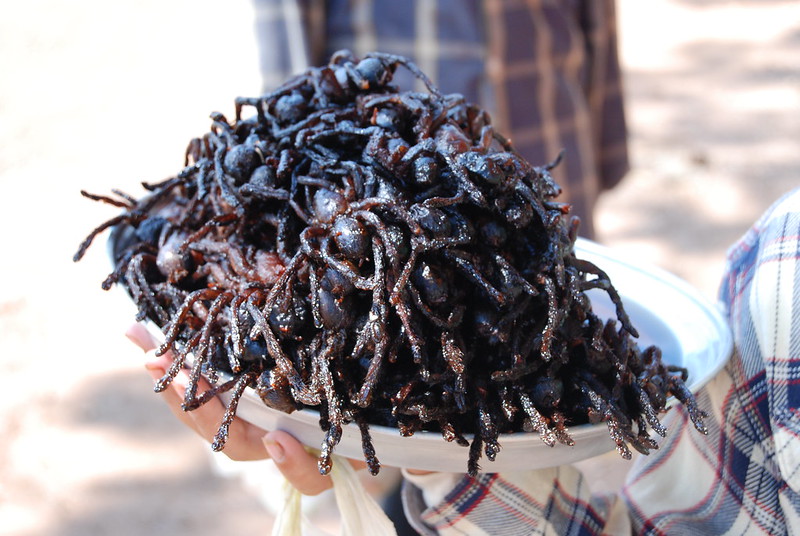
Fried tarantulas (Cambodia)
This favorite local snack is easy to find in food carts and many shops in Cambodia, as it is one of the most commonly enjoyed street foods in the country. While eating spiders (even if they are fried) may sound rather nightmarish to many Westerners, locals love them for their mild flavor and crispy texture. Most commonly just fried and tossed with salt and sugar, this creepy crawler has a delicate white meat inside its head and body and delightfully crispy legs. While most people skip eating the abdomen because it contains the intestines and egg sacks, some consider this the best part!

Casu Martzu (Sardinia)
Otherwise known as maggot cheese, this now illegal product was deemed “Most Dangerous Cheese” by Guinness World Records in 2009. The making of maggot cheese involves allowing pecorino to decay so that flies can lay their eggs inside. Once the maggots have hatched, they begin to eat their way through the cheese, releasing proteins in the process that create a creamy texture. In addition to the cheese’s silky smoothness, the flavor is said to be pleasantly earthy and spicy — if you don’t mind the crunch of maggot bodies.
While eating insects is nothing new to the world of global cuisine, the uniquely dangerous threat here is that the maggots may survive the eater’s chewing and stomach acids and worm their way through to the intestines, making the person horribly sick. Brave, to be sure. But still very sick.
While Casu Martzu is now illegal to produce, many still do so on the sly and sell it on the black market.

Snake wine (Vietnam)
Snake wine is exactly what it sounds like. The body of a snake is put into a bottle of a grain alcohol, most commonly a rice wine, left to sit for months while the snaky flavors infuse, and then enjoyed by the more adventurous drinkers out there. Some believe that snake wine has numerous medical benefits, such as curing disease, preventing or slowing hair loss, and improving sexual performance, though none of these claims are medically supported.
A more hardcore varietal of this delicacy is “snake blood wine.” It’s essentially the same product, only the belly of the snake is first slit, leaving the blood and other insides to help flavor the wine.
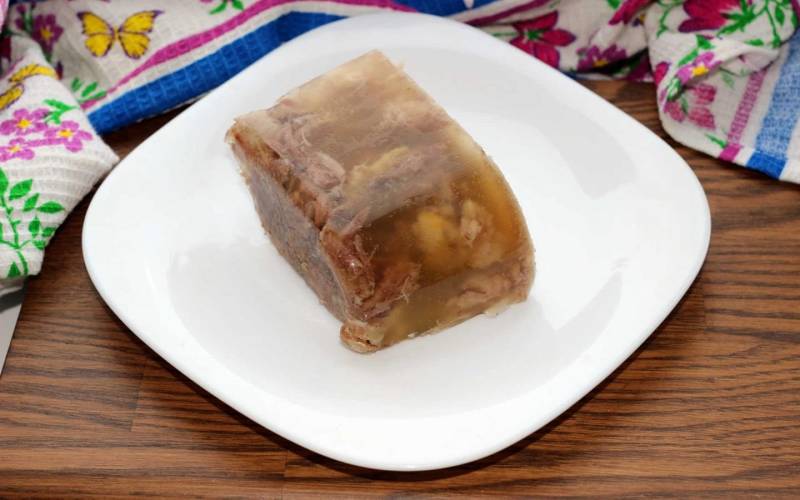
Jellied moose nose (Canada)
Moose are everywhere in Canada and Alaska. The enormous animal is often enjoyed for its flavorful, gamey meat and is considered to be a delicious food item. Moose can be prepared any way you can prepare beef, from burgers to roasts to meatloaf. This lean meat is both a delicious and practical choice in the North.
When it comes to moose, many people take nose-to-tail eating literally. This is both respectful to the animal sacrificed for our nourishment and wise economically and environmentally. Perhaps the idea of jellied moose nose isn’t all far-fetched. It may sound a bit peculiar, but dishes like this have been around forever and are enjoyed in many parts of the world — think head cheese or aspic. Jellied moose nose is the same concept. The white and dark meats found in the moose nose are boiled with herbs and spices and then set to cool in a broth. When the mixture has solidified, it’s cut and served in slices.

Rocky Mountain oysters (U.S.)
Cowboy caviar, calf fries, Montana tendergroins. Whatever you choose to call them, these little delicacies are some of America’s favorite family jewels. When bull calves are castrated, their testicles are cut off — and that’s how we get “Rocky Mountain oysters.” Sorry, fellas.
Most commonly deep fried, these little bull balls are most often served like buffalo wings, with plenty of sauce for dipping. Their deep-fried disguise serves them well, as people are often tricked into eating them without knowing exactly what they’re eating. For some, no trickery is required. Rocky Mountain oysters have such a big sack of fans that there are entire festivals dedicated to them. That’s just nuts.
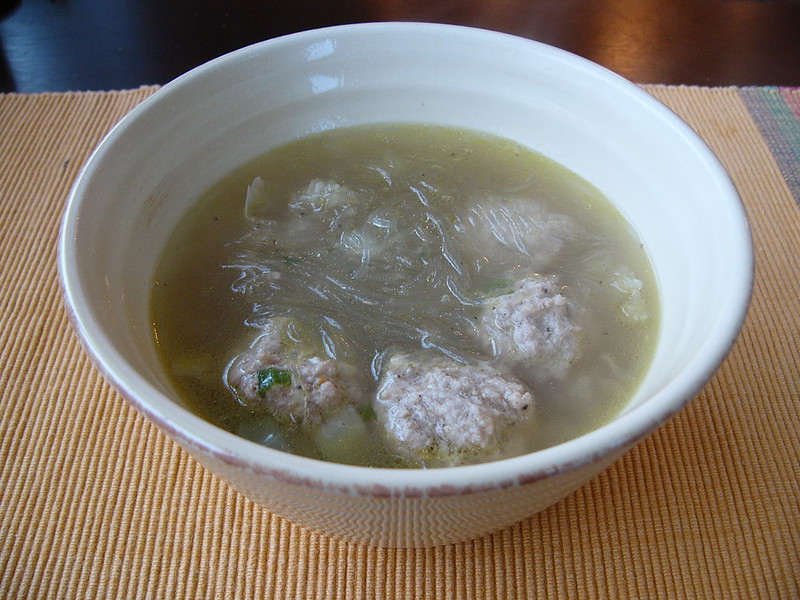
Bird’s nest soup (China)
This controversial soup is made from the nests of swiftlets, a small bird native to Southeast Asia. If you’re ordering soup to save a few pennies on lunch, this menu item isn’t the way to go. One bowl of bird’s nest soup can cost upwards of $100. The hefty price tag is due to the rarity of the nests and the danger of harvesting them. Three times a year, these special birds create their nests from their saliva and build them onto high walls of caves. These days, people have created “bird hotels” that are more efficient for harvesting these nests, but those found in the wild are still the most coveted.
Swiftlet saliva is said to contain magical properties that may cure cancer, help children grow taller, and even be something of an elixir of youth. No wonder it has such a high price tag.

Fugu (Japan)
If you like to live on the edge, fugu is a one-way ticket to the danger zone. This is one of the most dangerous and potentially fatal fish in the world, and still, people want to get a taste of the poisonous pufferfish. While it contains enough tetrodotoxin to kill a human in 20 minutes, the pufferfish is still coveted by foodies and thrill-seekers alike.
Because even the smallest mistake in preparation could be fatal, chefs in Japan must be specially trained and licensed in order to serve this delicacy. Still, more than 100 people die every year from its deadly deliciousness.

Goong Ten ‘dancing’ shrimp (Thailand)
This is a succulent shrimp dish with spicy, savory accents like peppers, fresh herbs, chili, and lime. What’s so peculiar about that list of ingredients, you ask? Well, nothing, except that the shrimp are tossed with these ingredients and served while they’re still alive. Yes, you read that correctly, the dish is served — and yes, it is intended to be consumed while the shrimp are still wriggling and writhing on the plate, providing an extra-squirmy texture to Goong Ten. One thing is for certain: At least you know they’re fresh; just don’t let your food escape before you eat it.
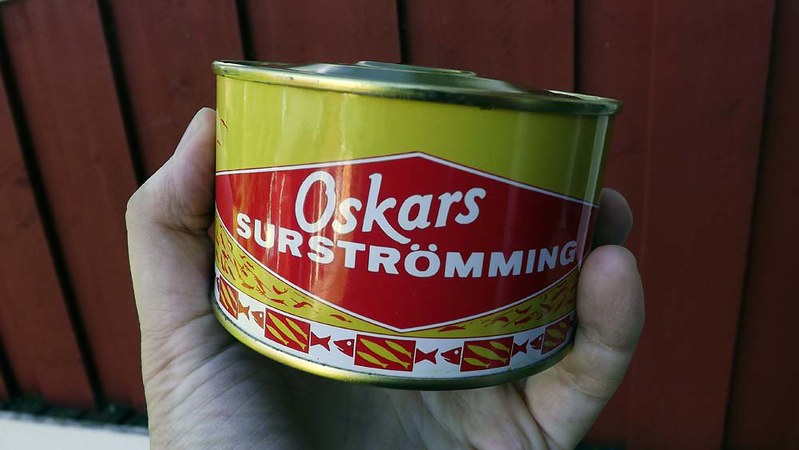
Surstromming (Sweden)
This one might have you asking, “So what’s the big deal about canned fish?” Sure, there’s certainly nothing peculiar or especially note-worthy about tinned seafood. Most of us have several kinds in our pantry at this very moment. So what gives?
Well, as bizarre as it sounds, surstromming’s odor is so offensive that daring to try it on camera has become somewhat of a TikTok challenge, with varying degrees of disgust, most pretty extreme. It’s so pungent, in fact, that surstromming has actually been added right alongside bombs and firearms on most airlines’ list of prohibited items. Obviously, it’d be hard to harm anything but someone’s senses with a little fish, but the odor is so extremely foul and lasting that planes must be completely — and expensively — sanitized after a surstromming encounter.
Some insist that its heavy umami and blue-cheese-like flavor is nothing short of delicious, but the whole thing smells pretty fishy to us.
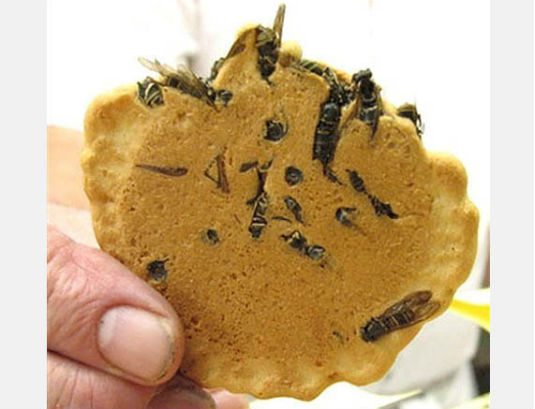
Wasp crackers (Japan)
Called Jibachi Senbei in Japan, this little cracker’s ingredients are pretty mundane: Eggs, sugar, oil, water, and, of course . . . digger wasps? They kind of look like chocolate chip cookies, if you replaced the delicious chocolate chips with stinging insects. While they have a painful sting when they are alive, these digger wasps, which are specially trapped to be used in wasp crackers, are boiled and dried before being added to the cracker, so you’re safe there. Though we’ve only ever known wasps as painful picnic bullies, apparently they’re also known for their pleasantly bitter, slightly acidic notes and shrimp-like texture. Who knew?

Century egg (China)
Yes, those are eggs in the above photo, and no, they are not a prop for a telling of the classic Dr. Suess tale Green Eggs and Ham. And they aren’t rotten either. They are known as century eggs, an egg dish made in China and other parts of Asia for, yes, centuries, and they are supposed to look like that. They are made by curing whole, shelled eggs (duck, quail, or chicken eggs) in clay, salt, wood ash, and quicklime. This curing process turns the whites of the eggs brown or black and makes them gelatinous while the yolks turn green.
After about two weeks, the eggs are removed from the curing mixture, washed, boiled, and shelled before serving. They are said to have a salty taste with a creamy texture and are often served as an appetizer with soy sauce.
Would we try them? Let’s answer that with a quote from Dr. Suess:
I would not like them here or there.
I would not like them anywhere.
I do not like green eggs and ham.
I do not like them, Sam-I-Am.



